Corrective waves fall into 4 different categories:
The zig-zag (3 variations: simple, double, triple)
The flat correction (3 variations: standard, irregular, doubly irregular)
The triangle (4 types: ascending, descending, closed, open)
The double three and the triple three
Contents
The zig-zag
The zig-zag features 3 waves:
(A): 5 descending waves
(B): 3 ascending waves
(C): 5 descending waves
The summit of wave B is lower than the start of wave A.
When a Zig Zag is followed by 3 waves and another Zig Zag, it’s known as a double Zig Zag (triple Zig Zags also exist).
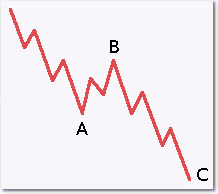
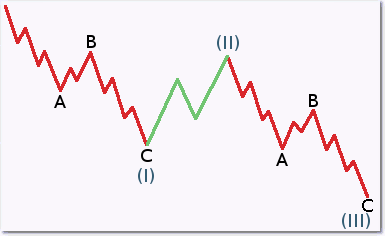
A corrective wave is always broken down into 3 waves.
The strength of sub-wave C is equal to that of sub-wave A or equal to .168 or 1.618 times that of sub-wave A.
If wave 2 is a zig-zag, wave 4 will be a flat correction.
If wave 2 is a flat correction, wave 4 wil be a zig-zag.
In a zig-zag, sub-wave C will end at the lowest point of wave A’s summit.
The flat correction
Flat correction
The summit of wave B is almost at the same level as the start of wave A.
Wave C is right across from wave A.
A flat correction can be broken down into a 3-3-5 pattern.
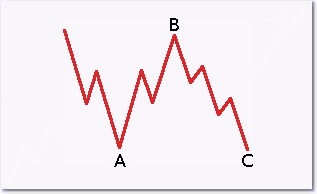
Irregular flat correction
The summit of wave B is higher than the start of wave A.
The end of wave C is lower or at the same level as the end of wave A.
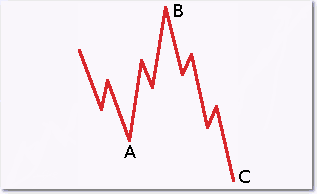
Double irregular flat correction
Wave C does not sink as low as wave A does.
In a flat correction, sub-wave B often retraces at least 61.8% of sub-wave A, but no more than 161.8%.
The maximum strength of sub-wave C is 2.618 times the strength of the largest between sub-waves A and B.
Sub-wave A is often a zig-zag.
Sub-wave B is rarely a flat correction.
Sub-waves A, B and C either have similar strengths, or sub-wave C has an amplitude equal to 161.8% of the strength of sub-wave A.
Sub-wave C often has at least 38.2% of the strength of sub-wave A.

Horizontal triangles
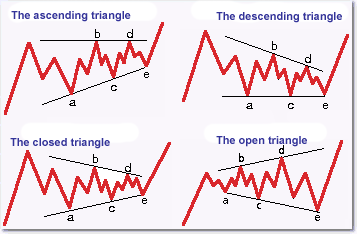
Corrective waves in a triangle configuration are comprised of 5 sub-waves (a, b, c, d, e).
These sub-waves are made of 3 waves, and each end features a trend line.
Triangles are often formed during wave 4.
Only sub-wave E can be a triangle.
Each sub-wave within a triangle retraces at least 50% of the preceding sub-wave.
Sub-waves that are in the same direction (A and C, B and D, A and E or C and E) usually have a strength that is related by a ratio of about .618.
The double three and the triple three
Double Three

The double three can be broken down into 7 sub-waves that are comprised of:
(A) A corrective wave comprised of 3 sub-waves (zig-zag or flat shape).
(B) A transition wave (1 sub-wave).
(C) A second corrective wave comprised of 3 sub-waves (zig-zag, flat or triangle shape).
Triple Three

The triple three can be broken down into 11 sub-waves that are comprised of:
A corrective wave (3 sub-waves), a transition (1 sub-wave), a second corrective wave (3 sub-waves), a second transition (1 sub-wave), and a third corrective wave (3 sub-waves).
Wave A of a double three or triple three cannot be a triangle.
Wave B of a double three or triple three is frequently a zig-zag.
Double threes or triple threes are often formed during wave 4.
The alternation rule
If wave 2 of an impulse is a deep retracement, wave 4 will often be a complex lateral correction, and vice versa.
A simple correction can be a flat correction or a zig-zag correction. A complex correction can be a triangle or a double three.
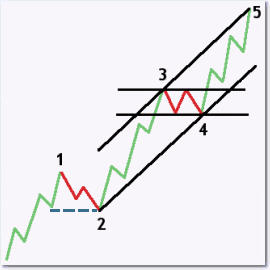
The depth of corrective waves
Corrective waves tend to retrace towards the end of sub-wave 4. This type of correction often appears during wave 4, and also if the first sub-wave of the impulse wave (wave 1 or 3) is an extension.
In the picture, you can see that wave 2 ends near the level of wave 1’s fourth sub-wave.
A corrective wave has a duration lasting between .4 – 1 times the duration of the preceding wave, except if the correction is a triangle.
Trend tunnels
In order to visualize the probable bounces of the following impulse waves, it is recommended that you trace straight trend lines ahead of time.
In order to trace this trend tunnel, connect the ends of waves 2 and 4.
If waves 1 and 3 are regular, a straight line passing through the summit of wave 3 will allow you to predict the summit of wave 5.
A straight line drawn from the summit of wave 1 will be even more useful to determine the summit of wave 5 if wave 3 is very powerful (almost vertical).
Ready to learn more? Check out these 3 rules for a correct elliot wave count.
